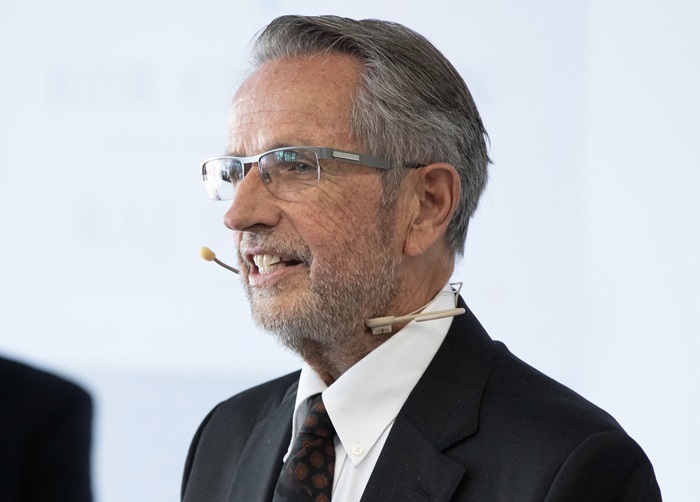Garry Ridge Says CEOs Must Realize the Impact of Work Life on Home Life
By Garry Ridge | January 11, 2024 4:46 am

Those of us who have studied employee engagement over the decades are very familiar with the principle that we want our people to feel they can be their most authentic selves at work. Unless your employee happens to be a serial killer as a side hustle, there really isn’t very much room for argument in the organizational development and leadership circles. Knowing we are accepted and fully welcome in an emotionally healthy workplace environment that provides for us and our family is the foundation of psychological safety that benefits everyone involved — customers, workplace colleagues, family members, the community, even the world.
The flip side of this engagement coin is also true. We have all accepted the idea that employees who feel they must leave their fundamental nature in the parking lot before heading to work bring only a portion of themselves through the front doors and past reception. If they don’t feel safe to be vulnerably authentic among their teammates, how safe do they feel to try out innovative ideas? Interact with each other candidly and caringly? Contribute their best efforts, fully expecting that they will be acknowledged, appreciated, trusted, supported and respected? Excited by their future? Proud to say that they work for their particular company?
If we want an engaged culture that supports these kinds of experiences and relationships at work (even if their workplace is now a home office or repurposed dining room table), we want our people to bring their whole selves to work every morning. (Even if the top half is webcam-meeting friendly while the bottom half still has coffee stains on the flannel. See it? Just there above the fleece in your slipper.)
But who have your people become at the end of their workday? How will they have been transformed by their workplace experiences and interactions all day long? Who will they be to their family members who are the first to see them at the end of the workday? Someone angry, resentful, stressed to the hilt? Or someone joyful, with plenty of positive emotional energy and affection for the family?
Even more to the point: Which version will make their spouse and children excited about their own future? Glad to be alive? Confident in the chances that dreams and plans really do come true?
In short: Which version makes for happy families, who will in turn make happy communities, which will in turn make a happier world?
On-the-job happiness defined.
Employer attempts to create happy workplace environments over the last 20 years have been met with spotty results, however sincerely well-intended they might have been. Some of us have been deeply studying Ken Blanchard, Simon Sinek, Marshall Goldsmith, Amy Edmondson, Barbara Fredrickson to build an authentically mentally healthy workplace culture.
When it comes to unpacking the essential definitions of happiness, and building the toolkit of what makes authentic and lasting positive emotions throughout all areas of our lives, Martin Seligman, the pioneer of positive psychology, has laid out a durable foundation of what consistently contributes to the happy experience in life over time. Happily, he has laid out these principles in a memorable acronym that applies both at work and at home (and in both environments in this remote working world): PERMA.
On a sidenote, Seligman, who invested the earliest years of his research in the study of happiness, eventually discarded “happiness” and replaced it with “flourishing.” He reasoned that “happiness” denotes a dependency on external and fleeting circumstances for the feeling of happiness to kick in. “Flourishing,” on the other hand, describes a quality of life that is built up and experienced over time. It can even be strengthened in the rough times. Do you want to have the fleeting experience of happiness that might come from a good dinner out or a workplace celebration? Or would you rather experience a lifelong epic saga that can be readily described as “flourishing”? Which narrative would you want to share with your children to keep them inspired about what might be possible for them in the future?
(In addition to the fact that PERMA has been validated to work, it also has the advantage that doesn’t require a monthly budget for food and beverage or capital construction. Like all things mindset-oriented, it’s free. You derive the benefits by how consistently you focus on them and encourage discussion around them.)
Using Seligman’s high-altitude definition of “flourishing,” we can paint a picture of a life beautifully lived, where the individual is able to make choices–even sacrifices — and take actions that more directly serve a compelling cause or mission. The way may not be smooth but, in retrospect, the individual is able to reflect on the unfolding of events and think: “Yes, this is worth it. I make a difference in a mission I deeply care about. And I’m making that difference in the company of people I also deeply care about and they care about me.”
How could that fail to inspire the family?
Unpacking PERMA.
As with most acronyms, PERMA makes the most sense unpacked and introduced piece by piece. These are the conditions of workplace happiness — or flourishing — even if that workplace is three steps away from the kitchen sink:
Positive emotions: By and large, your employees feel good about their work, their workdays, their working conditions, their teammates. There are ups and downs, of course. But overall, they know their days are well invested in the activities that are essential to the mission. And they feel good about life, their work, themselves as a result.
Engagement: There are multiple ways companies seek to deepen their relationship with their people — many of the actions and experiences described in the employee engagement surveys. The key performance indicators you may have on your company’s survey outline the very specific characteristics of the tribal culture that help your people focus on their work, feeling proud to be associated with the company, and safe in the companionship of colleagues up and down the org chart.
Relationships: The feeling of belonging to a community of people who welcome you — and you welcome them —is a critical human need. Shared positive experiences with our fellow tribe members serve to strengthen those bonds of trust and collaboration, breathing joy and celebration into their shared adventure in the company. Even negative experiences are powerful bonding opportunities, assuming they’re shared in the context of positive relationships.
Meaning: Flourishing blooms when everyone in your tribe sincerely cares about the positive outcome of the shared effort — the mission’s meaning or purpose. Dedication to the meaning of the work keeps everyone focused and appreciative of the opportunity to serve humanity and make the world a better place. In addition to the organization’s mission, each individual likely also has a personal meaning. The more the tribe knows about each other and what personal passions burn brightest for each individual, the more the tribe flourishes in a rich cultural environment of mutually positive regard.
Achievement: When a set of efforts, self-discipline, commitment results in the successful completion of the goal, the achievement is both individually gratifying and bonding as a tribe. Even the failure of an attempt at an achievement is an achievement in itself. I call all these experiences (positive and negative ones) “learning moments” that tribe members can freely share with each other to everyone’s benefit, without fear of retribution or career hazard. As a coach, when I have the joy of observing a tribe member grow from being hesitant to share learning moments to freely telling even embarrassing stories, I consider that an achievement, right there!
PERMA at home.
How happy can you imagine a family can be when it is parented by adults who had the joy of spending their workdays steeped in PERMA? We have adults who have children craving their attention and approval. What energy will be left for these little ones? What ideas about what’s possible for their own lives might fill their imaginations, supported by the example of their parents who share stories about how they tried and succeeded? Or even tried and failed, but were celebrated by their tribe for giving it their all anyway?
Who is the happier? The child with busy, distracted parents who tell them horror stories about how horrible work is? Or the child with tired but satisfied and inspired parents who still have the time, focus and energy to hear about their dreams and patiently help them plot the steps and skills acquisition necessary to achieve that dream future? Who is the most likely to be happy, positive and optimistic about their chances of flourishing as adults as well?
The leadership culture informed by PERMA gives its people all the essentials necessary to flourish at work. The family is paying attention at home.
Named by Inc. magazine one of the top 10 Most Admired CEOs in the World, Garry Ridge shares what he learned during his 25 years as CEO of WD-40 Company in his current role as consultant, coach and founder of global firm The Learning Moment. His forthcoming book, “Any Dumb-Ass Can Do It,” is scheduled for release in 2024.
We honored him as a Social Capital CEO in our feature article “Authentic CEOs: Antidote to the Counterfeit Culture.”




